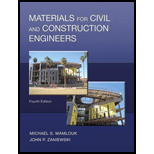
Materials for Civil and Construction Engineers (4th Edition)
4th Edition
ISBN: 9780134320533
Author: Michael S. Mamlouk, John P. Zaniewski
Publisher: PEARSON
expand_more
expand_more
format_list_bulleted
Question
Chapter 10, Problem 10.6QP
To determine
The moisture content of the given wood.
Expert Solution & Answer
Want to see the full answer?
Check out a sample textbook solution
Students have asked these similar questions
As shown in the figure below, a 1.5 m × 1.5 m footing is
carrying a 400 kN load.
P
Depth (m)
0.0
1.0
2.0
Df
Groundwater
table
(Yw = 9.81 kN/m³)
3.5
Yt = 16.5 kN/m³
E = 9,000 kPa
Sandy
soil
Ysat 17.5 kN/m³
E = 15,000 kPa
6.0
Stiff Clay
(OCR = 2)
Bedrock
Ysat 18.0 kN/m³
eo = 0.8
Cc = 0.15, Cr = 0.02
Eu =40,000 kPa
(a) Estimate the immediate settlement beneath the center of the
footing. Assuming that Poisson's ratios of sand and soft clay are
0.3 and 0.5, respectively. Use numerical integration approach.
For the calculations, use layers (below the bottom of the footing)
of thicknesses: 1 m; 1.5 m, and 2.5 m.
(b) Determine the primary consolidation settlement beneath the
center of the footing.
(c) Redo Part (b) if OCR=1.1.
Note: Use the 2:1 method to determine the stress increase below
the footing. For parts (b) and (c), use the one-dimensional
consolidation theory.
Consider the cross-sections illustrated in the next slides. Implement a
cross-sectional analysis based on a layered discretisation of the cross-
section as required at the following.
1) Develop the implementation of an analysis to estimate the nonlinear
response of the composite steel-concrete section, of the reinforced
concrete section and of the steel section shown in following slides
(using material nonlinear models provided in the support files).
Provide the details of the numerical implementation with clear
explanations of all steps.
Hint: the implementation can be done in Excel.
2) Discuss how the 3 cross-sections (shown in the next slides) compare
to each other in terms of embodied carbon under the condition that
the cross-sections possess the same nominal moment capacity (i.e. the
peak moment achieved in the moment-curvature diagram).
The discussion should include at least 2 sets of the sections (each set
contains one composite section, one reinforced concrete section and
one…
Consider the following static route choice problem where 110 vehicles travel from point A to
point B. The corresponding travel time (in minutes) of each link is as follows:
t₁ = x1; t₂ =
x2 + 20; t3x3 + 10; t₁
= 3×4
where
Xi
denotes the number of vehicles that choose link i.
Find the number of vehicles that travel on each link when
a. The user equilibrium condition (UE) is satisfied, where vehicles select the route with the
minimum travel time; and
b. The system optimum condition (SO) is satisfied, where the total travel time is minimised.
C.
Report the total delay savings when satisfying SO instead of UE.
2
B
A
3
4
Chapter 10 Solutions
Materials for Civil and Construction Engineers (4th Edition)
Ch. 10 - What are the two main classes of wood? What is the...Ch. 10 - Prob. 10.2QPCh. 10 - Prob. 10.3QPCh. 10 - Discuss the anisotropic nature of wood. How does...Ch. 10 - Prob. 10.5QPCh. 10 - Prob. 10.6QPCh. 10 - Prob. 10.7QPCh. 10 - Prob. 10.8QPCh. 10 - Prob. 10.9QPCh. 10 - Prob. 10.10QP
Ch. 10 - Prob. 10.11QPCh. 10 - Prob. 10.12QPCh. 10 - Prob. 10.13QPCh. 10 - Prob. 10.14QPCh. 10 - Prob. 10.15QPCh. 10 - Prob. 10.16QPCh. 10 - Prob. 10.17QPCh. 10 - Prob. 10.18QPCh. 10 - Prob. 10.19QPCh. 10 - Prob. 10.20QPCh. 10 - Prob. 10.21QPCh. 10 - Prob. 10.22QPCh. 10 - Prob. 10.23QPCh. 10 - A wood specimen was prepared with actual...Ch. 10 - A pine wood specimen was prepared with actual...Ch. 10 - Prob. 10.26QPCh. 10 - Prob. 10.27QPCh. 10 - Prob. 10.28QPCh. 10 - Prob. 10.29QPCh. 10 - Prob. 10.30QPCh. 10 - Prob. 10.31QPCh. 10 - Prob. 10.32QPCh. 10 - Prob. 10.33QP
Knowledge Booster
Similar questions
- = α₂+ Assume an origin is connected to a destination with two routes. Assume the travel time of each route has a linear relationship with the traffic flow on the route (t₁ = α₁ + b₁x₁ ; t₂ b2x2). Determine under what condition (e.g. a relationship among the parameters of the performance functions) tolling cannot reduce the total travel time of the two routes.arrow_forwardBeban berjalan pada konstruksi balok seperti pada gambar, tentukan besar gaya dalam yang terjadi dengan metode Garis Pengaruh. Gaya dalam berupa : Reaksi tumpuan RA dan RB, Gaya lintang max di titik C, Momen Maksimum di titik C A + Dimana: B D 10 5 m 5 m P1 = 12t P2 = 6t P3 = 18t q= 6 t/m 2 3 q = 6 t/m P1 P2 P3arrow_forwardConsider the following static route choice problem where 110 vehicles travel from point A to point B. The corresponding travel time (in minutes) of each link is as follows: t₁ = x1 ; t₂ = = x2 + 20; t3 = x3 + 10; t₁ = 3x4 where Xi denotes the number of vehicles that choose link i. Find the number of vehicles that travel on each link when a. The user equilibrium condition (UE) is satisfied, where vehicles select the route with the minimum travel time; and b. The system optimum condition (SO) is satisfied, where the total travel time is minimised. C. Report the total delay savings when satisfying SO instead of UE. 2 A B 3 4arrow_forward
- = Assume an origin is connected to a destination with two routes. Assume the travel time of each route has a linear relationship with the traffic flow on the route (t₁ = α₁ + b₁×₁ ; t₂ b2x2). Determine under what condition (e.g. a relationship among the parameters of the performance functions) tolling cannot reduce the total travel time of the two routes. a2+arrow_forwardFor the soil system presented below, calculate and draw diagrams of distributions of the totaland effective stresses and pore water pressure. Assume an upward water flow with a velocity of0.000,001 cm/s.arrow_forwardRefer to attached problem.arrow_forward
- Calculate: a) effective stresses at points A and B before the placement of foundations 1 and 2, b)the increase of pressure at point A as a result of the placement of the circular foundation 1, c) theincrease of pressure at point B as a result of the placement of the strip foundation 2.arrow_forwardConsider the total head-loss in the system forthis flow is 18.56 ft (head-losses in first and second pipe are 13.83 ft and 4.73 ftrespectively). Please show numerical values for EGL/HGL at the beginning/end/intermediatechange point. (Point distribution: elevation determination 5 points, EGL, HGL lines 4points)arrow_forwardAs shown in the figure below, a 1.5 m × 1.5 m footing is carrying a 400 kN load. P Depth (m) 0.0 1.0 2.0 Df Groundwater table (Yw = 9.81 kN/m³) 3.5 Yt = 16.5 kN/m³ E = 9,000 kPa Sandy soil Ysat 17.5 kN/m³ E = 15,000 kPa 6.0 Stiff Clay (OCR = 2) Bedrock Ysat 18.0 kN/m³ eo = 0.8 Cc = 0.15, Cr = 0.02 Eu =40,000 kPa (a) Estimate the immediate settlement beneath the center of the footing. Assuming that Poisson's ratios of sand and soft clay are 0.3 and 0.5, respectively. Use numerical integration approach. For the calculations, use layers (below the bottom of the footing) of thicknesses: 1 m; 1.5 m, and 2.5 m. (b) Determine the primary consolidation settlement beneath the center of the footing. (c) Redo Part (b) if OCR=1.1. Note: Use the 2:1 method to determine the stress increase below the footing. For parts (b) and (c), use the one-dimensional consolidation theory.arrow_forward
- Assuming that the whole DMV is only handled by one queue and one server and both the arrival rate (20 customer per hour) and the service rate (30 customers per hour) random variables are Markovian. (a) What is the mean queue length? [3 pts] (b) Percentage of Idle time of the server? [3 pts] (c) Average number in the queue? [3 pts] (d) Average number in the system? [3 pts] (e) The average wait time in the queue? [3 pts] (f) The average wait time in the system? [3 pts] (g) The probability that no one is in the system. [2 pts]arrow_forwardA toll booth on the Thruway experiences an average inter-arrival time of 3 minutes between each vehicle. As an operator, you want to have a mean queue length of at most 2 vehicles. What mean service rate (per hour) will the toll booth need to provide?arrow_forwardA freeway is to be designed at a location on level terrain for an annual average daily traffic (AADT) of 45,000 vehicles per day. For a conversion of AADT to an annual hourly volume, assume that the K-factor is 0.10 (i.e., the 30th highest hourly volume of the year). In addition, 55% of the peak-hour traffic volume is expected to travel in the peak direction (D = 0.55). This freeway segment will be for regular commuters. Other estimates include: PHF of 0.95, free-flow speed of 65 mph, and 20% trucks of the traffic stream. In order to determine the number of lanes required to provide at least LOS C, answer the following questions. (a) Determine Free Flow Speed (FFS) [4 pts] (b) Find the directional design-hour volume (DDHV) [4 pts] (c) Find fHv [4 pts] (d) Determine the number of lanes required. [4 pts] (e) Check the expected LOS for 2-directional lanes on this freeway segment. [4 pts]arrow_forward
arrow_back_ios
SEE MORE QUESTIONS
arrow_forward_ios
Recommended textbooks for you
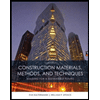 Construction Materials, Methods and Techniques (M...Civil EngineeringISBN:9781305086272Author:William P. Spence, Eva KultermannPublisher:Cengage Learning
Construction Materials, Methods and Techniques (M...Civil EngineeringISBN:9781305086272Author:William P. Spence, Eva KultermannPublisher:Cengage Learning Materials Science And Engineering PropertiesCivil EngineeringISBN:9781111988609Author:Charles GilmorePublisher:Cengage Learning
Materials Science And Engineering PropertiesCivil EngineeringISBN:9781111988609Author:Charles GilmorePublisher:Cengage Learning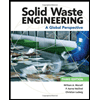 Solid Waste EngineeringCivil EngineeringISBN:9781305635203Author:Worrell, William A.Publisher:Cengage Learning,
Solid Waste EngineeringCivil EngineeringISBN:9781305635203Author:Worrell, William A.Publisher:Cengage Learning, Traffic and Highway EngineeringCivil EngineeringISBN:9781305156241Author:Garber, Nicholas J.Publisher:Cengage Learning
Traffic and Highway EngineeringCivil EngineeringISBN:9781305156241Author:Garber, Nicholas J.Publisher:Cengage Learning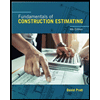 Fundamentals Of Construction EstimatingCivil EngineeringISBN:9781337399395Author:Pratt, David J.Publisher:Cengage,
Fundamentals Of Construction EstimatingCivil EngineeringISBN:9781337399395Author:Pratt, David J.Publisher:Cengage,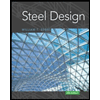 Steel Design (Activate Learning with these NEW ti...Civil EngineeringISBN:9781337094740Author:Segui, William T.Publisher:Cengage Learning
Steel Design (Activate Learning with these NEW ti...Civil EngineeringISBN:9781337094740Author:Segui, William T.Publisher:Cengage Learning

Construction Materials, Methods and Techniques (M...
Civil Engineering
ISBN:9781305086272
Author:William P. Spence, Eva Kultermann
Publisher:Cengage Learning

Materials Science And Engineering Properties
Civil Engineering
ISBN:9781111988609
Author:Charles Gilmore
Publisher:Cengage Learning

Solid Waste Engineering
Civil Engineering
ISBN:9781305635203
Author:Worrell, William A.
Publisher:Cengage Learning,

Traffic and Highway Engineering
Civil Engineering
ISBN:9781305156241
Author:Garber, Nicholas J.
Publisher:Cengage Learning

Fundamentals Of Construction Estimating
Civil Engineering
ISBN:9781337399395
Author:Pratt, David J.
Publisher:Cengage,

Steel Design (Activate Learning with these NEW ti...
Civil Engineering
ISBN:9781337094740
Author:Segui, William T.
Publisher:Cengage Learning